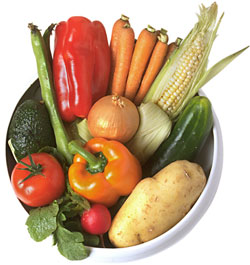ORAC value is the Oxygen Radical Absorbance Capacity of food.
Oxygen Radical Absorbance Capacity (ORAC) is a method of measuring antioxidant capacities in biological samples in vitro.
The free-radical theory of aging (FRTA) states that organisms age because cells accumulate free radical damage over time. A free radical is any atom or molecule that has a single unpaired electron in an outer shell. While a few free radicals such as melanin are not chemically reactive, most biologically-relevant free radicals are highly reactive. For most biological structures, free radical damage is closely associated with oxidative damage. Antioxidants are reducing agents, and limit oxidative damage to biological structures by passivating free radicals.
The free radical theory of aging implies that antioxidants such as Vitamin A, vitamin C, vitamin E, and Superoxide dismutase will slow the process of aging by preventing free radicals from oxidizing sensitive biological molecules or reducing the formation of free radicals. The antioxidant chemicals found in many foods are frequently cited as the basis of claims for the benefits of a high intake of vegetables and fruits in the diet.
Nonetheless, some recent studies tend to show that antioxidant therapy have no effect and can even increase mortality. Proponents of the theory claim that this phenomenon can be explained by hormesis: The addition of antioxidants can lead to a decrease of normal biological response to free radicals and lead to a more sensitive environment to oxidation. Furthermore, a recent study tracking the eating habits of 478,000 Europeans suggests that consuming lots of fruits and vegetables has little if any effect on preventing cancer.
Free Radicals
Free radicals play an important role in combustion, atmospheric chemistry, polymerization, plasma chemistry, biochemistry, and many other chemical processes, including human physiology. For example, superoxide and nitric oxide regulate many biological processes, such as controlling vascular tone. Such radicals can even be messengers in a phenomenon dubbed redox signaling. "Radical" and "free radical" are frequently used interchangeably, although a radical may be trapped within a solvent cage or be otherwise bound.
Antioxidants
Although oxidation reactions are crucial for life, they can also be damaging; hence, plants and animals maintain complex systems of multiple types of antioxidants, such as glutathione, vitamin C, and vitamin E as well as enzymes such as catalase, superoxide dismutase and various peroxidases. Low levels of antioxidants, or inhibition of the antioxidant enzymes, cause oxidative stress and may damage or kill cells.
As oxidative stress might be an important part of many human diseases, the use of antioxidants in pharmacology is intensively studied, particularly as treatments for stroke and neurodegenerative diseases. However, it is unknown whether oxidative stress is the cause or the consequence of disease.
 Antioxidants are widely used as ingredients in dietary supplements in the hope of maintaining health and preventing diseases such as cancer, coronary heart disease and even altitude sickness. Although initial studies suggested that antioxidant supplements might promote health, later large clinical trials did not detect any benefit and suggested instead that excess supplementation may be harmful. In addition to these uses of natural antioxidants in medicine, these compounds have many industrial uses, such as preservatives in food and cosmetics and preventing the degradation of rubber and gasoline.
Antioxidants are widely used as ingredients in dietary supplements in the hope of maintaining health and preventing diseases such as cancer, coronary heart disease and even altitude sickness. Although initial studies suggested that antioxidant supplements might promote health, later large clinical trials did not detect any benefit and suggested instead that excess supplementation may be harmful. In addition to these uses of natural antioxidants in medicine, these compounds have many industrial uses, such as preservatives in food and cosmetics and preventing the degradation of rubber and gasoline.Phytochemicals
Phytochemicals are chemical compounds that occur naturally in plants, such as beta-carotene. The term is generally used to refer to those chemicals that may affect health, but are not yet established as essential nutrients. While there is abundant scientific and government support for recommending diets rich in fruits and vegetables, there is only limited evidence that health benefits are due to specific phytochemicals.
 There is evidence from laboratory studies that phytochemicals in fruits and vegetables may reduce the risk of cancer, possibly due to dietary fibers, polyphenol antioxidants and anti-inflammatory effects. Specific phytochemicals, such as fermentable dietary fibers, are allowed limited health claims by the US Food and Drug Administration (FDA).
There is evidence from laboratory studies that phytochemicals in fruits and vegetables may reduce the risk of cancer, possibly due to dietary fibers, polyphenol antioxidants and anti-inflammatory effects. Specific phytochemicals, such as fermentable dietary fibers, are allowed limited health claims by the US Food and Drug Administration (FDA).Some phytochemicals with physiological properties may be elements rather than complex organic molecules. Abundant in many fruits and vegetables, selenium, for example, is involved with major metabolic pathways, including thyroid hormone metabolism and immune function. Particularly, it is an essential nutrient and cofactor for the enzymatic synthesis of glutathione, an endogenous antioxidant.
Phytochemicals in freshly harvested plant foods may be destroyed or removed by modern processing techniques, possibly including cooking. For this reason, industrially processed foods likely contain fewer phytochemicals and may thus be less beneficial than unprocessed foods. Absence or deficiency of phytochemicals in processed foods may contribute to increased risk of preventable diseases.
Interestingly, a converse example may exist in which lycopene, a phytochemical present in tomatoes, is either unchanged in content or made more concentrated by processing to juice or paste, maintaining good levels for bioavailability.
Source, Images: http://en.wikipedia.org/wiki/



0 comments:
Post a Comment